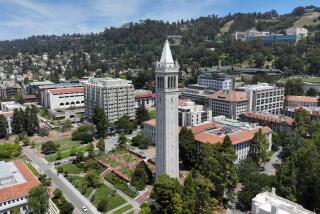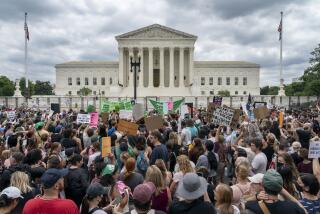Not Going Conservative, Study Finds : Today’s College Frosh as Liberal as Those of ‘60s
- Share via
College students of the ‘80s may profess to be more middle-of-the road in their views and are clearly more interested in making money than were their ‘60s counterparts, but on a broad range of social and political issues, they are just as liberal, if not more so, than were their predecessors of two decades ago.
According to a comprehensive national survey assessing the changing attitudes and aspirations of students from 1966 to 1985, the widespread recent publicity about students’ preoccupations with jobs and money is well-founded. But the oft-repeated assertion of the growing conservatism of the American college student is not borne out by the facts.
“What the pundits have told us about the conservative tendencies of students is simply not true,” said UCLA professor Alexander W. Astin, one of the authors of the study. “Materialism in the job market may have been mistaken for conservatism in the political arena. But conservatism in politics is not a characteristic of most American college students today any more than it has been in the past. In some areas, they are even more liberal today.”
The study, prepared by Astin and Kenneth C. Green, is a compilation of surveys conducted every year for the last 20 years by UCLA’s Higher Education Research Institute. Generally considered the most complete and reliable indicators of attitudes in American higher education, the surveys have involved nearly 6 million students and about 100,000 faculty members at more than 1,250 colleges and universities.
In the political arena, the study found, a majority of students of both sexes say that they are neither ultraconservative nor far left in their beliefs. In 1985, 19.5% identified themselves as conservative and 22.4% said they were liberal or to the left, while 56.7% said they were “middle-of-the road,” up from 45.4% in 1970.
Yet, when asked their views on specific issues, a substantial majority of those who entered college last fall continued to support, as had their counterparts of the previous two decades, most traditional liberal causes.
For example, 60.5% supported the concept of national health insurance, 73.3% favored increased taxation of the wealthy, 54.9% supported legal abortions. By large majorities, today’s students want strong government intervention in such areas as the control of environmental pollution, consumer protection and energy conservation.
Support for busing as a means of achieving school integration has actually risen from 37% in 1976 to 54.4% in 1985. And opposition to increased defense spending has also increased, from 61.2% in 1983 to 73.2% in 1985.
Astin said in a telephone interview that there was a “widespread misperception” that college students had favored President Reagan over the more liberal Democratic candidates in the 1980 and 1984 elections. While young people in general apparently favored Reagan, Astin estimated that college students, in fact, were about evenly split.
“Nobody really looked at college students as such,” he said. “Rather they looked at the 18-to-24 age group.” There is a good evidence, Astin said, that the more educated and affluent a young person is, the less he or she was likely to favor Reagan or his policies over those of more liberal candidates.
Conservative Area
In only a handful of areas have today’s freshmen become more conservative than were their counterparts in the 1960s and 1970s, the study found. While legalization of marijuana was supported by more than half of the freshmen surveyed in 1977, it is now endorsed by only about a quarter of students. Opposition to capital punishment has also weakened--from 53.9% favoring abolition in 1969 to 26.6% in 1985.
Today’s students are far more concerned about getting high-paying jobs after college than students were in the ‘60s.
Twenty years ago, “being financially very well off” was a value subscribed to by only 43.8% of the students surveyed. Today, 70.9% said that was very important. In contrast, in 1967 the single most important value held by 80% of entering freshmen was “developing a meaningful philosophy of life.” Today it has dropped to seventh position and is endorsed by only 43.3% of students.
Astin said that the most dramatic change he has observed over the 20-year period of the survey is “the extent to which the women’s movement of the late 1960s has affected American higher education in the 1980s.”
Irreversible Change
“It has penetrated almost every aspect of college life,” he said, “and there seems to have been no diminishing of that impact. In that sense, the changes seem irreversible. Women will surely never go back to where they were two decades ago.”
Women, once the minority in American higher education, are now the clear majority, making up 51.8% of those entering classes in 1985, compared to 43.3% in 1969, the study found.
Despite a declining interest among male students in professions such as law and medicine, there has been a dramatic increase among females in those traditionally male-dominated fields, the study said. While the proportion of males interested in medical degrees dropped 10% over the last 16 years, the proportion of women headed for medical careers increased by more than 270%. In the field of law, males’ aspirations fell by one-third between 1970 and 1985, while interest among women in law careers increased nearly fivefold.
“It is perhaps ironic,” Astin said, “but one of the major effects of the women’s movement is that women now look more like men.”
Drinking, Smoking
Both males and females are more likely today than they were in the past to drink and less likely to take drugs, the survey found. A striking change is that women are now almost twice as likely to smoke cigarettes as their male classmates.
There was only one other area of the survey in which male and female students differed sharply: attitudes toward casual sex. In 1984, the study found, a solid majority of men--63%--approved of sex between people who have known each other for only a short time, but only one-third of the women approved.
While noting that the survey deals with the aspirations of freshman and does not directly reflect the careers and values of the students in later life, the researchers said that their studies have shown that the “tentative choices” contained in the survey “are in fact very good predictors” of ultimate career paths.
In assessing their data of the last two decades, the researchers found some “disturbing” trends which, although generally known, have never before been so thoroughly documented.
Not as Well Prepared
By their own accounting, students are not as well prepared today as were their predecessors. Two out of every five students in 1985 indicated that an “important” or “very important” reason for deciding to go to college is “to improve my reading and study skills”--double the number who held those views in 1971.
The study also detected broad shifts in career plans and aspirations of students over the two decades.
Perhaps the most alarming trend documented, co-author Green said, “is the degree to which today’s college students are no longer interested in pursuing careers in science and teaching--fields that are already running short of trained personnel.”
At the same time, business has emerged as the No. 1 major and career choice of today’s freshmen. In the fall of 1985, almost one freshman in four planned to major in business (24.8%), up from 14.3% in 1966.
Declining Interest
Meanwhile, a declining interest in obtaining doctoral degrees, coupled with an 85% decline in the proportion of freshmen interested in college teaching, suggests that the nation’s colleges and universities “will soon begin to experience real staffing problems as large numbers of current faculty begin to retire in the 1990s.”
The study also showed a 74% decline in the proportion of freshmen interested in elementary or secondary teaching--from 23.5% in 1968 to 6.2% in 1985.
“What is particularly disturbing about these trends is what they mean for the future of the country,” Green said. “To put these percentages in some kind of perspective, you must understand that a 1% shift from one year to the next now represents about 17,000 students.”
Considering the condition of public schools in America, Green said, “Over the long run, we have a very serious problem that universities and the country as a whole are going to have to address.”
More to Read
Sign up for Essential California
The most important California stories and recommendations in your inbox every morning.
You may occasionally receive promotional content from the Los Angeles Times.










